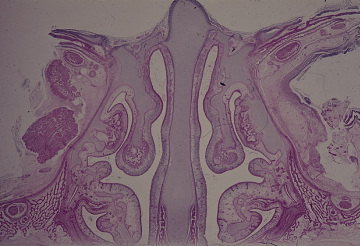- 呼吸器1.鼻腔.
ヒト、胎生末期の胎児、フォルマリン固定、セロイディン包埋、
呼吸器1.鼻腔.
ヒト、胎生末期の胎児、フォルマリン固定、セロイディン包埋、
H-E染色、x 5.---------------------------------------
これはヒトの胎生末期の胎児の鼻腔の前頭断面である。画面の中央部に--
直立しているのが鼻中隔で、その左右に接する空間が左右の鼻腔である。-
鼻腔の外側壁からは上・中・下の鼻甲介が鼻腔内に突出して、鼻腔を上・---
中・下の鼻道に分ける。上鼻甲介と鼻中隔の間の上鼻道の最上部は------
嗅部と呼ばれ、ここは臭いを感知する特別の上皮(嗅上皮)で覆われて-----
いる。嗅部以外の鼻腔の部分は、呼吸の際に空気が通る空間で呼吸部と---
呼ばれ、多列繊毛上皮で覆われている。この標本では中鼻甲介の発育は---
いまだ微弱である。------------------------------------------------
Respiratory organs 1. Nasal
cavity.
Human embryo at term, fixation
with formalin, embedding
with celloidin, H-E stain, x 5.-------------------------
This is a frontal section of the nasal cavity of an human embryo
at term. --
In the middle there stands vertically and sagittally the nasal
septum------
and divides the nasal cavity into the right as well as the left
half. From ----
the lateral wall of each cavity protrude upper, middle, and lower
nasal -----
conchae and divide the cavity into 3 nasal tracts. The uppermost
narrow --
portion of the upper nasal tract is called regio olfactoria and
covered with -
olfactory epithelium. Except for the regio olfactoria the nasal
cavity is all --
over covered with ciliated columnar epithelium. The middle nasal
concha ---
is less developed in this specimen. ----------------------------------
戻る

